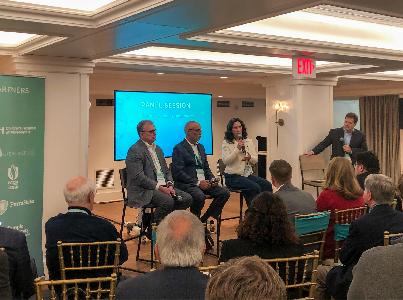Data center provider vXchnge seeks to empower Philadelphia’s rising startup scene with the opening of a new facility, said John Panzica, the company’s senior vice president of sales. It also wants to get more involved in the tech community.
Last September, the company opened its 15th data center nationally at 1500 Spring Garden St. in Center City. The historic location used to be the manufacturing plant of GlaxoSmithKline. The vXchnge business is three years old, but its senior management comes from Switch and Data, a data center company acquired by Equinix in 2010. Switch and Data has some history here — its first facility was located in Philly.
Panzica said that he hopes the new data center will attract local startups. Having a data center nearby means less latency than for web-based services. Less latency, which is the time it takes for your computer to access information from data servers the world over, means happier users.
Panzica has met with local business leaders and startup incubators, and vXchnge plans to participate in upcoming local tech events, he said.
Panzica — who lives in Princeton, N.J., but refuses to pick a side on the Flyers-Devils hockey rivalry — isn’t new to the area. In the late ‘90s during the dot-com boom, he helped open Internap’s office in Philadelphia.
“I’ve gotten a chance to see the boom and the cycles the city has gone through,” he said. “I’m especially excited now to see some of the innovation that’s coming out of the startup community.”
The Philly data center will host local companies and national businesses that want to be in this market, Panzica said. Comcast is one of vXchnge’s big-name customers in Philadelphia. He said customers typically come from the telecom and cloud space. Other clients in the company’s 15 data centers around the country include TidalScale, Cogent Communications and Integra Telecom.
So, why come to Philly now? During a tour of the facility, Panzica told us that vXchnge has come to Philadelphia as part of a strategy “to serve local markets from local markets.”
Historically, from a telecom infrastructure standpoint, Philadelphia had been served from New York or Ashburn, Va., Panzica said. However, the rise of mobility and content in recent years has made it more important to use localized infrastructure, he said.
It didn’t hurt Philly’s chances that the Philadelphia-Camden-Wilmington metropolitan statistical area was ranked as the sixth largest MSA in the 2014 census.
“No longer is it good enough to serve Philadelphia from New York if you’re a content company,” he said.
The Philadelphia data center is 70,000 square feet and has five on-site technicians. Like other vXchnge data centers, the facility places an emphasis on power efficiency.
“In older technology designs, data centers used to cool an entire site,” said Panzica. “What we’re doing is using air containment technologies … where we’re actually building these pod systems — cabinets on both sides, cold aisle in the middle [and] hot aisle on the other side — and we’re putting containment walls and ceilings and doors around it. Essentially what you’re doing is trapping all the cold air and you’re only cooling the pod systems as opposed to the entire data center.”
The Philadelphia facility even takes advantage of the city’s cold winters, drawing in outside air through the roof and using it to cool the servers within, he said.
These techniques contribute to a power usage effectiveness (PUE) score for vXchnge data centers of about 1.3, which is more efficient than some older designs by other companies rated at 2.0 and above. PUE measures how much energy is used by the computing equipment compared to cooling and other facility equipment, and is equal to the total facility energy divided by the IT equipment energy.
The facility also boasts a security system that would not seem out of place in a Mission: Impossible movie. There are six points of access control from the lobby to a cabinet area, said Panzica. When we entered the data center, security staff performed an iris scan and then entered a PIN into a keypad.
But just in case that’s not enough security for you, the facility has 100 surveillance cameras watching over all activity in the data center.
Within is a customer lounge with soft green chairs, guest WiFi, Ethernet connections and a kitchen with all the coffee an IT pro could need.
The security system, like the pods and everything else, are “space-age” in design, said Panzica.
Join the conversation!
Find news, events, jobs and people who share your interests on Technical.ly's open community Slack

Philly daily roundup: Earth Day glossary; Gen AI's energy cost; Biotech incubator in Horsham

Philly daily roundup: Women's health startup wins pitch; $204M for internet access; 'GamingWalls' for sports venues

Philly daily roundup: East Market coworking; Temple's $2.5M engineering donation; WITS spring summit



